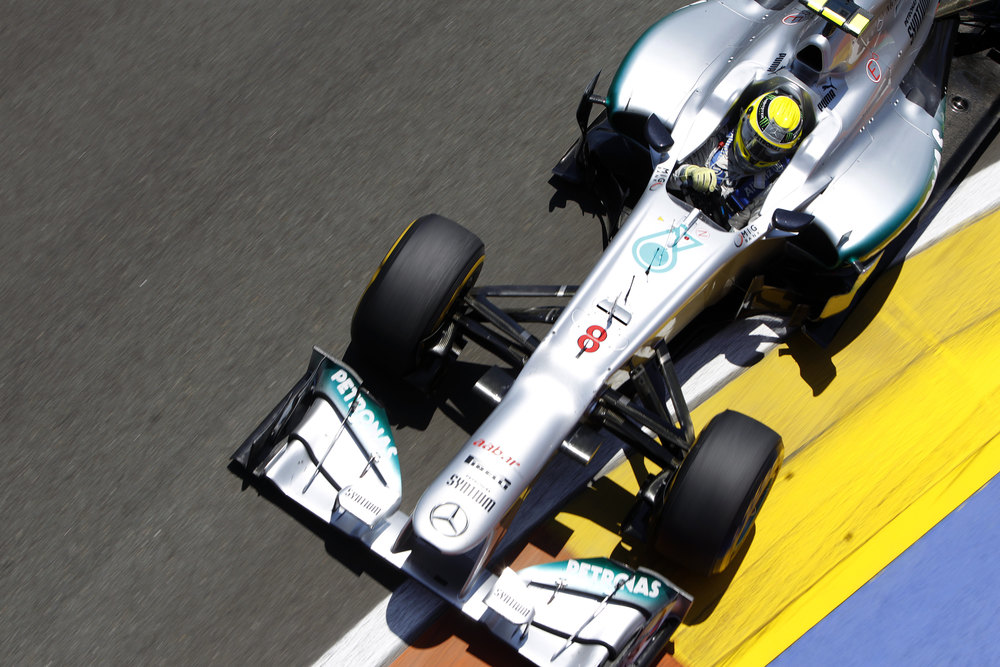 Michael Schumacher makes a pit stop at the 2012 Hungarian Grand Prix. Image courtesy of Mercedes AMG Petronas.
Michael Schumacher makes a pit stop at the 2012 Hungarian Grand Prix. Image courtesy of Mercedes AMG Petronas.
The following is another informational piece on Formula 1 for our novice readers, from Austinite Mike Boone. Mike introduced many Austinites to the Mercedees AMG Petronas F1 Team earlier this year.
// Welcoming F1 Back to the States
Although Formula One has graced the presence of our US shores since its inaugural year in 1950, its culture and leading edge technology is a mystery to most US citizens. Diversity amongst the sport’s fans, technology leaders, race drivers, engineers, automobile and engine manufacturers has resulted in an experience unlike any other in the world. Regardless of your culture, social standing or hemisphere, the sheer thrill of watching an automobile be managed by a driver from 0 to 100mph and back to 0 again, will leave you wanting to see and learn more about the sport.
These diverse influences have allowed it to evolve in every almost area of society. The great news for us, in the US, is that we can be educated fans without having to travel overseas to every race. Just as Formula One has been the worldwide leader in the commercial rights and marketing business, it has also become a leader in the effective use of social media opportunities like Facebook and Twitter. The great news for us is we in the US can now enjoy the up close and personal experience of the race culture in Austin, Texas.
Below are some fundamental and historical facts about Formula One that will give a new fan just enough information to spark a desire to learn more.
// Getting Technical
Every driver is assigned a number with the prior year champion donning number one and his or her teammate getting number two. Driver numbers are then assigned based on the constructor championship rankings. Although the number thirteen hasn’t been used since 1976.
Amongst those fans that are familiar with both NASCAR and Formula One you will find a common debate to be which series requires the higher level of talent. Although the NASCAR drivers are not likely to move to Formula One; Jacques Villeneuve, Juan Pablo Montoya, Nelson Piquet Jr and Scott Speed have moved from Formula One to NASCAR.
Formula One race cars are one of the first to promote the use of carbon-fiber composites, which has allowed the constructors to create very light and strong chassis. The car, engine, and driver, weigh as little as only 1411 lbs.
This year, the engines must be 2.4-litre non-turbo V8s. The gas they run on is a higher grade that what we use in our commuter cars but still very similar in natue
The steering wheel is a work of art and for several thousand dollars, prior versions can be purchased as just that, art work. Looks aside, the steering wheel has been turned into a central command center for the driver where controls for changing gears, applying the rev. limiter, adjusting fuel/air mix, change brake pressure, and of course speaking to the engineers. There is an LCD screen that displays the speed, lap times and various other metrics. The wheel hub holds the gear change paddles and a row of lights that change with rpm at each gear.
The various braking systems in F1 cars have led to many advances in our current model production cars. Today, the brakes and aerodynamics allow an F1 car can decelerate from 62 to 0 mph in 48 ft., compared with production sports cars taking 102 ft.
As great as it is to have the ability to stop quickly when going from 180 mph to 40 mph at a tight turn, accelerating quickly is even more impressive.
- 0 to 100 km/h (62 mph): 1.7 seconds
- 0 to 200 km/h (124 mph): 3.8 seconds
- 0 to 300 km/h (186 mph): 8.6 seconds
Although the true budget to develop and build the formula one car for any team is very complicated, estimates for Honda, Toyota, McLaren-Mercedes, and Ferrari have been above $200,000,000 in a single year.
// Racing technologies that have transferred to consumer cars
Lotus built a car with an aluminum chassis in 1962, instead of the traditional design. This proved to be the greatest technological breakthrough since the introduction of mid-engine cars. Other technologies we see in the production world today that we can thank Formula One for include:
- Push Button Start versus key
- Left hand key start on Porsche
- Transmissions – Paddle Shifters
- Multi-Link Suspensions
- Tire technologies, both rubber and pattern
- Disc and Ceramic Brakes
- Aerodynamics
- Auto body materials – carbon-fiber, aluminum
- The rearview mirror



